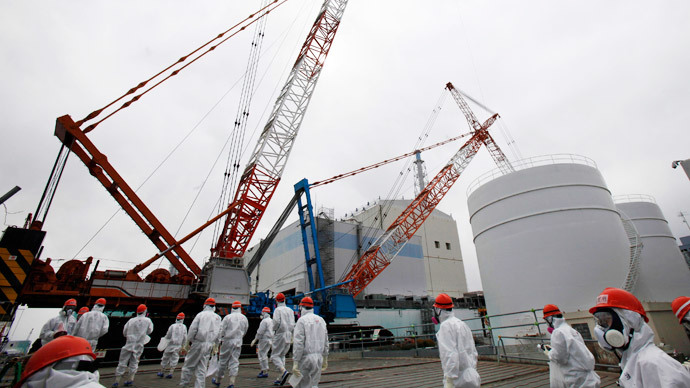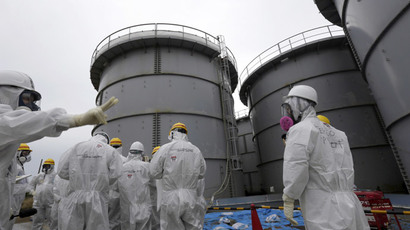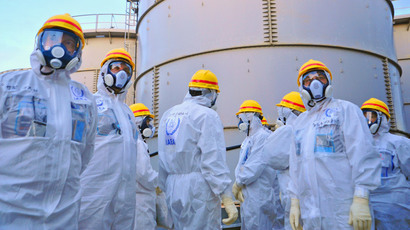Fukushima water decontamination suspended indefinitely

Treatment of radioactive water at Fukushima Daiichi nuclear power plant might be indefinitely suspended after malfunctions crippled the water purification process and recontaminated thousands of tons of partially purified water, Japanese media report.
The failure in the system, known as the Advanced Liquid Processing System (ALPS), is the latest setback in Tokyo Electric Power Co.’s (TEPCO) uphill battle to stockpile radioactive water, which is ballooning at a rate of 400 tons per day.
TEPCO said up to 900 tons of water, which had not been sufficiently cleaned in the ALPS equipment, flowed into a network of 21 tanks that were holding 15,000 tons of treated water. Not only have the 21 tanks been rendered unusable, but all 15,000 tons of previously cleaned water will now have to be retreated.
While efforts are underway to measure the full extent of the contamination, TEPCO officials said the problem was not noticed prior to March 18 because no abnormalities were detected in water sampled on March 14, Japan’s Asashi Shimbun daily reports.
“We never expected radioactive water to flow into the storage tanks,” Masayuki Ono, acting general manager of TEPCO’s Nuclear Power & Plant Siting Division, told the paper. “We should have been better prepared. We have no idea how long it will take to clean them if we decided to do so.”
The ALPS system was developed to dramatically curb the radiation level of highly contaminated water that is accumulating at the plant. The APS consists of 14 steel cylinders through which the contaminated water is filtered. After the filtering, waste materials like the absorbent and remaining sludge are transferred to high-integrity containers (HICs) that are transported to a temporary storage facility.
The ALPS can remove 62 different types of radionuclides, including strontium and cobalt from contaminated water. While the system cannot remove tritium – a radioactive isotope of hydrogen – the purification of water through the system is expected to reduce damage levels if water leaks from storage tanks.
The equipment, which is supposed to be able to treat up to 750 tons of contaminated water a day, has been undergoing trial runs since March 2013. The system, however, has been plagued with problems from the outset. The latest glitch and the subsequent recontamination was caused when one of the three ALPS lines failed to remove radioactive substances to a sufficient level.
Water from the March-17 sample water that was supposed to have been treated along one of the three channels of the ALPS system was discovered to still contain one-10th of the original concentration of radioactive substances. The system, however, is supposed to reduce that level to one-100,000th of the initial readings.
The finding prompted TEPCO to shut down ALPS operations along all three channels on March 18. In another incident, an ALPS pump stopped working in February, leaving only one of the two lines being tested at the time operational. With only one line working, the daily clean-up capacity dropped to one-third its capacity: 250 tons. Approximately one week prior, around 100 tons of highly radioactive water leaked from one of the plant’s tanks.
In mid-January, TEPCO warned that nuclear radiation at the boundaries of the damaged facility had jumped to eight times the government safety guidelines, while, only a week into the New Year, plant operators once again had to stop using its systems to decontaminate radioactive water. Compounding their problems at the time, a crane used to get rid of the container from the ALPS ceased functioning.
Meanwhile, a United Nations rights investigator said Japan should expand its cancer tests beyond the thyroid screenings being employed by local authorities, Bloomberg reports.
“Why don’t we have a urine analysis, why don’t we have a blood analysis?” said Grover, who also recommended that the tests be expanded to a broader geographical area. “Let’s err on the side of caution,” Grover, a UN special rapporteur who surveyed the events surrounding the March 11, 2011 disaster, said in Tokyo on Thursday.
To date, 75 cases of thyroid cancer have been found among the 254,000 residents who had been tested as of February 7, the Asahi Shimbun reported at the time.
Only residents of Fukushima Prefecture who were18 or younger under at the time of the 2011 Fukushima nuclear disaster are eligible to receive the thyroid gland tests administered by the prefectural government.
Medical and government officials in Fukushima said they did not believe those 75 instances of cancer are linked to the 2011 disaster.
On March 11, 2011, a 9.0 megathrurst earthquake struck off the coast of Japan. The quake triggered a massive tsunami, which inundated the nuclear power plant causing three reactors to melt down. More than 18,000 people were killed across Japan, with entire communities destroyed or deemed uninhabitable.














